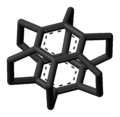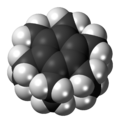 | |||
| |||
| Names | |||
|---|---|---|---|
| Other names [2.2.2.2.2.2](1,2,3,4,5,6)Cyclophane | |||
| Identifiers | |||
3D model (JSmol) | |||
| ChemSpider | |||
PubChem CID | |||
CompTox Dashboard (EPA) | |||
| |||
| |||
| Properties | |||
| C24H24 | |||
| Molar mass | 312.456 g·mol−1 | ||
Except where otherwise noted, data are given for materials in their standard state (at 25 °C [77 °F], 100 kPa). | |||
Superphane is a 6-fold bridged cyclophane with all arene positions in the benzene dimer taken up by ethylene spacers. The compound has been of some scientific interest as a model for testing aromaticity and was first synthesised by Virgil Boekelheide in 1979. [1] [2] Superphane is the base compound for a large group of derivatives with structural variations. The analogs with 2 to 5 bridges are also known compounds.[ citation needed ] The benzene rings have been replaced by other aromatic units, such as those based on ferrocene or stabilized cyclobutadiene. Numerous derivatives are known with variations in the type and length of the bridging units.


